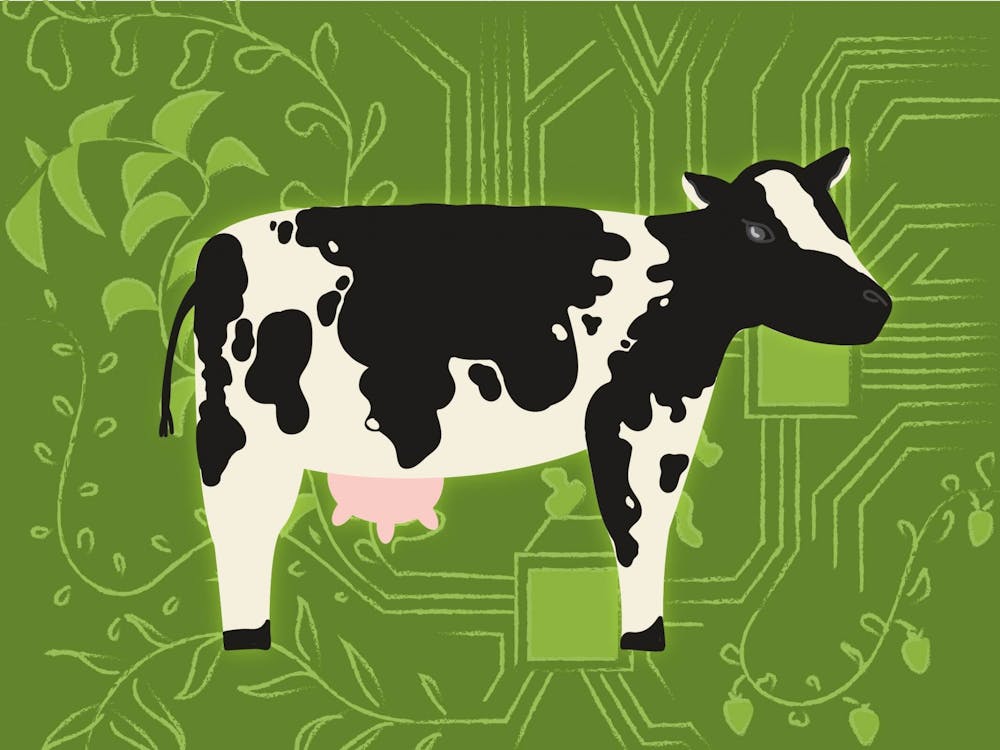For many people, the intersection between the rise of technology and antiquity of organic farming is like a battlefield. Over the past few decades, the war has continued to rage on. The industrialization of agriculture has led to the vision of agriculture many people have today—large gas-powered machines plowing fields of a single crop; farmers spraying chemical fertilizers and pesticides, allowing them to run off into our rivers; livestock pumped with antibiotics to counteract the inevitability of disease from compact living quarters.
One side of the battle claims that industrial farming has been essential to feeding our rapidly growing population by providing cheap food at high quantities and reallocating our labor force through a decrease in the number of farmers. Proponents of industrialized farming believe that our immense population, eight billion as of 2022, is simply unsustainable under any other agricultural model. Organic farming, for example, is not able to produce the great quantity of food that industrial farms can produce (especially considering that only 10.5% of the workforce in the U.S. is allocated to farming, according to the USDA).
The other side of the battle claims that industrial farming is causing more harm than good. The chemicals used in industrial farming pollute the soil, water and air through runoff and nitrogen production. Globally, raising livestock accounts for 7.1 gigatonnes of carbon dioxide, making up 14.5% of all greenhouse gas emissions according to the Food and Agriculture Organization of the United Nations. Monoculture depletes the soil of nutrients and biodiversity while also contributing significantly to erosion. The antibiotics used in livestock have made large contributions to the global problem of antibiotic resistance. The machines and transportation needed on these farms continue to add to fossil fuel depletion and air pollution.
So the question is: can the relationship between technology and sustainable farming be reconciled, or will technology always be the antithesis of sustainable farming?
Mai Dinh, a USC student involved in Sustainable Carolina, says that the future of sustainable farming will be greatly empowered by technology.
“Technology helps to maximize yields and nutrient efficiency while decreasing needed resources,” Dinh said. “This, overall, helps to create environmentally friendly and convenient farming systems.”
For example, Dinh explains a promising farming technique called hydroponics. Hydroponics consists of growing plants using a water-based nutrient solution instead of soil. According to Dinh, this technology has made great advancements in making horticulture more sustainable. Hydroponics can be used in indoor and inert vertical systems, reducing land usage while eliminating the need for harmful fertilizers, herbicides and pesticides. Hydroponics is also extremely efficient: it can be successful in any season and water condition.
“Less water is also needed since it is recaptured through pipes in an active system to be reused,” Dinh said. “So, hydroponics is efficient in terms of water usage and nutrient cycling.”
This makes hydroponics an effective tool for agriculture in places with poor soil, limited space and arid climates, leading to reduced food shortages and food deserts in these areas. Hydroponics also lowers emissions from transporting food long distances.
However, hydroponics isn’t without its flaws. According to Dinh, global agriculture is very unlikely to completely convert to a process like hydroponics. Not only is it very expensive, but it also uses a lot of energy and creates a hefty carbon footprint. “If renewable sources of energy could be used to power hydroponic systems instead, then that would help reduce the carbon footprint significantly,” Dinh said.
Hydroponics is a perfect example of the issue with sustainable farming: there is no one right and perfect answer. More than likely, the future of switching to sustainable agriculture will be a combination of many different sustainable processes. For example, Dinh mentions that beans and grains need more input to develop, so they may not be the most beneficial candidates for using hydroponics to lower emissions. However, plants that are mostly made of water like leafy greens would thrive. A different sustainable method could be used for more nutrient-demanding crops.
Some of these sustainable processes will only be possible with the advanced technology we have today. According to the U.S. Farmers and Ranchers in Action organization, these technological processes will primarily occur in digital sensors, irrigation, drones, biotechnology and fleet management. Digital sensors can monitor most every farm process from livestock movement to micro-climate data. Sensors can tell farmers important information about crops such as pH, water intake, temperature and more. This can help farmers make decisions to keep the crops and the environment around them healthy. In order to use water more efficiently, wireless remote monitoring and control systems allow for farmers to better regulate their irrigation systems. They can see exactly how much water, electricity and chemicals are being used, and can thus adjust their consumption.
Even drones have been given a sustainable upgrade on many farms. Previously used for distributing chemicals, many drones today are used for capturing aerial imagery to monitor growing conditions for the crops. In the realm of biotechnology, CRISPR technologies—used for editing genes—are being used to create crops with higher yields and disease tolerance, therefore reducing the need for pesticides and fertilizers. CRISPR has also been used to improve the use of dietary phosphorus and lessen the environmental issues caused by animal manure. In fleet management, GPS technology can be used to gain information on engine speed, fuel usage and maintenance. Combining this information with crop input can tell farmers which machines are worth continued use in terms of crop yield and lowering emissions.
The world of science fiction is also rapidly encroaching on our future farms with the rise of agricultural robots. According to Artificial Intelligence +, these robots are largely used in tandem with farmers to automate certain functions, increasing precision and sustainability in their practices. These robots pull weeds out of fields without disrupting nearby plants and harvest crops using software to identify ripe fruit. They also plant seeds, saving time and money for the farmers, and water plants with soil moisture sensors to determine exactly how much water the plants need.
John Deere is jumping on the proverbial AI wagon as well. According to CNBC, at a Consumer Electronics Show in Las Vegas in January of 2022, Deere announced its fully autonomous 8R farm tractor. The tractor is driven by AI instead of a farmer, and will use GPS-based self-steering technology to determine where to place seeds with extreme precision. Its sensors will be able to distinguish weeds from crops and use micro-climate technology to determine if an individual crop actually needs certain chemicals and water. This helps to minimize the amount of water and chemicals needed to grow crops.
It appears that technology and agriculture don’t seem to be separating any time soon. Although technology has created industrial farms with dangerous environmental implications, it also appears to be the only way to switch to more sustainable farming practices. With our growing population, it is doubtful that there is only one green solution that we can apply to save the planet. Rather, it is going to take many different farmers using many different technological tools to improve their sustainability. To reach completely sustainable farming, technology and agriculture are going to have to fight on the same side.



